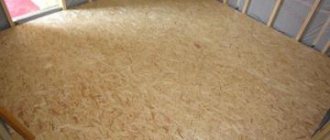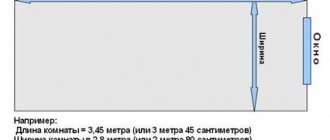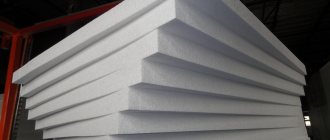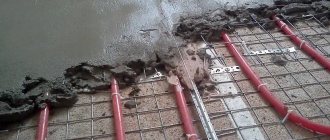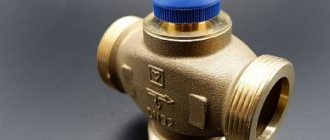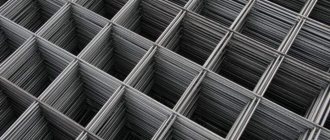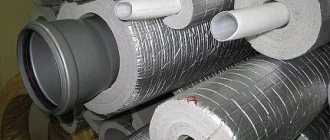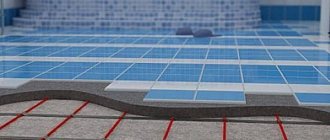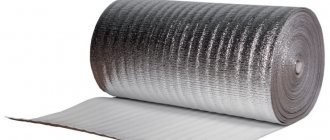Laying methods
Let's consider which side is the correct way to lay the insulation with foil on the floor.
Heat-saving properties depend on how correctly the insulation is installed.
Foil reflects infrared radiation, therefore, the metallized layer must be laid so that it faces the inside of the room.
Insulation of concrete floor
Place the casing with the foil side down
Most often, the rolled material is fixed to the concrete base using a special glue made on the basis of rubber.
Installation sequence:
- We prepare the surface. We level the slab so that there is no large difference in height. We seal all cracks and cracks with cement mortar.
- We spread the material on the floor with the foil layer facing up and cut it to the required length. We move the strip aside and apply glue to the place where it is laid. Let it sit for a few minutes according to the instructions for the glue. We lay and press the material well. We place the strips close to each other.
- We secure the joints with foil tape, which is sold in hardware stores.
For additional insulation of cold floors, wooden logs can be laid on top, the space between which is filled with slab insulation. Floorboards or sheet material (OSB, fiberboard, chipboard) are placed on top of it. For an interesting comparison of foil materials, watch this video:
https://youtube.com/watch?v=RgKvM3-JFRU
Wood floor insulation
It is most convenient to lay the material on an adhesive layer
It is most convenient to lay foil insulation on a wooden floor, which has a bottom self-adhesive layer.
If you bought material without an adhesive base, then you need to fix it with staples using a construction stapler or with double-sided tape.
Laying sequence:
- We remove the baseboards, remove debris and dust using a vacuum cleaner.
- If the boards have uneven surfaces, we sand them with a special machine and, if necessary, sand them (remove the top layer of the board).
- We seal all existing cracks with wood putty.
- We prime with an antiseptic composition.
- We measure the room, cut the roll, and lay it up with foil. It can be easily cut to size using sharp sewing scissors.
- Lay out the strips end to end. We wait a day for the material to settle and straighten out. If the heat insulator has a self-adhesive base, gradually remove the protective film and press it tightly to the surface. We lay the next strip end-to-end.
- We fix the joints of the strips with foil tape.
Foil insulation for heated floors
When laying insulation under heated floors, lay the material with the foil facing up so that it reflects heat into the room
The base for heated floors must be flat without differences in height or defects. All errors must be eliminated.
Stages of laying thermal insulation with a layer of foil:
- We lay out the foil material in strips end to end, and glue the joints with special tape.
- We install a system of electric or water heated floors on top.
- We lay hydro- and vapor barrier material. It will prevent concrete from leaking onto the floor heating elements.
- We fill the screed with a thickness of 30-50 mm, depending on the type of heating elements and the functional purpose of the room.
Insulation under floating screed
Having bought a two-layer material, you don’t have to bother with the question of which side to lay the insulation on
It is characterized by the fact that the slab is not rigidly fastened to the concrete screed; thermal insulation is laid between them.
Installation sequence:
- We prepare the base and eliminate all defects.
- We plaster the lower part of the walls.
- We stick damper tape around the perimeter of the walls; its height should be equal to the thickness of the floor: from the slab to the floor covering.
- We prime the base in two layers. Apply the next layer after the previous one has dried.
- We lay thermal insulating foil boards with the foil facing up. We use a metallized coating that is resistant to cement mortar. We lay the slabs strictly in a horizontal plane, close to each other. Uneven laying of insulation boards contributes to the formation of cracks in the concrete solution.
- We glue the joints of the plates with tape.
- We pour the concrete screed.
Lightweight and durable insulation with a layer of foil is becoming increasingly popular among consumers and professional builders due to its high heat retention and ease of installation. For more information about isolation, watch this video:
We looked at how to properly lay foil material for high-quality floor insulation. Thermal insulating material is always laid with foil on the outside; if you lay it the other way around, it will not retain heat fully.
Types of thermal insulation with foil
Heated floor power per 1 m2 calculation procedure.
Heated floor power per 1 m2 So, on the building materials market you can find a variety of types of thermal insulation materials covered with foil; in particular, it could be:
- foamed polyethylene;
- expanded polystyrene;
- basalt insulation;
- mineral wool;
- multifoil;
- foilisolone.
Let's take a closer look at them. The most popular thermal insulation material used for heated floors is foil polystyrene foam. Quite durable material that is not afraid of sudden temperature fluctuations. In general, it is able to cope with changes in air temperature from -180 to +180 degrees without damage, but, of course, in domestic conditions the floors definitely do not heat up to that extent. Also, polystyrene foam is not afraid of exposure to various chemicals. It is not afraid of rot, various pathogenic microorganisms do not settle on it, which also demonstrates the material as safe for human health.
Mineral wool is purchased and used much less frequently, even with a layer of foil. It is especially not suitable for installing a water heating system. The fact is that in the event of a liquid leak, the material will easily become saturated with it and lose all its qualities - it will not be able to retain heat. And it is not recommended to use mineral wool for electric heated floors. The main reason for negative reviews is that this material, when heated, begins to release substances that negatively affect the body. Therefore, such insulation is often used only in industrial facilities. In fairness, it is worth noting that mineral foil wool also has an advantage - a low fire hazard class.
Foamed polyethylene is another commonly used type of underfloor heating. Durable, plastic, not afraid of moisture, it is not afraid of various chemicals, and pathogenic microorganisms do not settle on it. All these advantages make foil polyethylene one of the best materials for thermal insulation. It can be used both under water heated floors and under electric floors, and its service life can be very long.
On a note! Foamed polyethylene also copes well with such tasks as noise absorption. Its main drawback is the fear of ultraviolet radiation, but under the floor covering sunlight will not reach the material.
Basalt insulation is not used in residential buildings. It is not afraid of sudden temperature changes and can easily withstand from -200 to +700 degrees, which is why it does not burn. This thermal insulation material is used in the aircraft industry.
Folgoizolon is often used in the construction/repair of saunas and baths, as it is not afraid of either moisture or sudden changes in temperature. The service life of the material is quite long, it does not rot, has increased sound insulation properties, and is safe from an environmental point of view. But foil isolon is very expensive, so it is practically not used in residential buildings.
There is another type of thermal insulation with a foil layer. It is known as multifoil and consists of several layers. The foil layer is covered with bubbles filled with air, then polyethylene and polypropylene film are laid. Under the foil layer there is a special protective coating. If you use this type of thermal insulation, heat loss will be reduced to a minimum. In addition, multifoil is not afraid of high humidity.
Attention! When installing a heated floor system, you should not use materials intended for insulating walls and other parts of the building. On the floor they will experience strong mechanical stress, and therefore can quickly lose their properties. Only use materials that are specifically designed for installation on the floor.
Only use materials that are specifically designed for installation on the floor.
Briefly about the manufacturer
Penofol is a brand name for foamed foil polyethylene. In Russia it has official permission for its production.
There are analogues of penofol on the market, but they are produced under other names: Ecofol, Isoflex, Izolon, Tepofol. When purchasing, you need to require documents for the material confirming its quality, otherwise you can buy a fake, which, unfortunately, is present on the market.
With the help of foiled penofol, it is possible to retain heat in the winter and, thereby, save on heating, and in the summer, to minimize the heating of the house.
Foil insulation and warm floor application features
Which coating is better for a warm water floor?
Most often, foamed polyethylene is used as a base, which allows you to vary the total thickness of the material from 2 to 10 mm. Laying is carried out under the screed as a heat-reflecting and insulating substrate when installing a heated floor. The most popular brands are Isolon, Folgoizol, Ecofol, Isoflex.
If a decision is made to install a water heated floor, often aluminum foil for a heated floor is applied as a coating to foamed polystyrene, which is made in the form of rigid slabs that can withstand fairly large loads and are highly resistant to dampness.
The main advantages of using foil insulation for heated floors are:
- high reflectivity;
- resistance to moisture;
- long service life;
- excellent heat, sound and vapor barrier characteristics;
- fast and convenient installation;
- ease;
- resistance to temperature influences.
When using them, no additional surface treatment with any protective agents is required. They are environmentally friendly and do not contain carcinogenic components. Foil for underfloor heating - the ideal solution
But if it is important for you to take such a step, after weighing all the pros and cons, you need an expert opinion, professional consultation, call. We will be happy to help you
Examples
The following models of foil insulation can be found on sale:
- TFP-3.5:
| Specifications | Values |
| The basis | Fiberglass |
| Upper layer | Aluminium foil |
| Waterproof at a pressure of 100 Pa for 72 hours | Absolute |
| Roll dimensions | 10 by 1 m |
| Price | 207 rubles |
TFP-3.5 has the highest performance properties and cost in comparison with other samples of foil insulation
- HMAP-3.5:
| Specifications | Values |
| The basis | Fiberglass |
| Upper layer | Metallized film |
| Waterproof at a pressure of 100 Pa for 72 hours | Absolute |
| Roll dimensions | 10 by 1 m |
| Price | 121 ruble |
The KhMAP-3.5 model is simplified by using a metal coating instead of a foil coating, due to which it costs less
Laying slab material
Composition of a heated floor cake laid on sand. Installation recommendations and options
Reflective thermal insulation in slabs
Reflective thermal insulation in slabs is installed primarily under heated floors, although it can also be used as regular insulation. With foil mats, make a floating screed and lay them between the joists.
Floating screed
Step 1. The concrete surface of the floor slabs is leveled using putty and grinding. Clean from dust.
Step 2. Using a level gauge, mark the screed pouring line on the walls.
Step 3. A damper tape is attached to the walls around the perimeter of the room and the base is primed.
Kermi damper tapes
Step 4. Plates are taken with a metallized coating, since aluminum is corroded by cement. Glue is applied pointwise to the base of the mats, after which the insulation is laid on the floor with the reflective layer facing up. When laying insulation, carefully adjust the joints so that gaps do not form.
Step 5. The joints are taped, and then the heat-insulating layer is filled with screed mortar. Level the mixture with a wide spatula or rule and leave until dry. After this, you can lay the finishing coating.
Insulation by joists
Step 1. Remove the floor covering, clear the base of debris, check the integrity of the joists, and, if necessary, repair damaged elements.
Step 2. Place waterproofing material on top of the joists and secure it with a stapler on the inside of the beams, spreading the film well on the floor. The edges of the canvases are overlapped by 10-15 cm.
Step 3. The space between the logs is filled with foil plates, laying them in one or two layers. The slabs of the second layer must overlap the seams of the lower layer. A gap of 1.5-2 cm is left between the reflective coating and the upper edge of the logs. If it is not possible to leave a gap, a sheathing of 20x40 mm slats is placed on top of the logs.
Foil basalt mats
Step 4. Further actions depend on the type of flooring. If it is linoleum or laminate, the rough base is covered with sheet material - plywood, chipboard, OSB. If the floor is made of boards, they are placed directly on the joists.
Table of the main properties of foil thermal insulators
Installation of an electrical cable system using a substrate
The preparatory work before installing the heating model is identical to the installation work of an infrared heated floor. The installation itself is performed in the following sequence:
- Slab polymer insulation is placed on the clean base of the room.
- Vapor barrier layers are laid over the entire area of the room.
- Install a polymer bedding.
- The plastic mesh is installed.
- Cables are secured to it using polyethylene clamps.
- Fill the screed.
The floor covering is installed on the hardened concrete.
It is not recommended to carry out this installation work yourself. It is better to invite an experienced specialist to carry them out. Since mistakes made can not only affect the family budget, but also damage heating systems.
Optimal substrate options
Each insulation manufacturer advertises its products in every possible way, trying to increase its demand. Therefore, you should not listen to the demands that they put forward. The following indicators are considered the optimal solution when choosing.
Thermal conductivity
The lower these indicators, the better the performance of the substrate. This parameter depends on the material being manufactured, as well as on its thickness. To increase the heat supply rate, the underfloor heating substrate must have a foil layer that will reflect infrared rays. And also for these indicators, the manufactured material must have strength and resistance to static and dynamic loads, be environmentally friendly, have resistance to temperature changes and resistance to deformation.
Manufacturability
To facilitate installation work, the lining should be made of lightweight materials that will not exceed a thickness of 5 millimeters and can be easily cut with scissors. Foamed polystyrene foam is considered one of these materials, as it is more technologically advanced to use. Insulation made from it is flexible, which certainly makes it easier to arrange the joints between the bases of rooms and walls. If you choose sheet plywood or chipboards, installation work will take a lot of time, since it will be more difficult to fit them in these places.
Relieving qualities
To simplify installation work, some manufacturers mounted protruding bosses or drew a mesh on the surface of the insulation. Thus, when installing in a water system, they can be fixed simultaneously with the gasket. This in turn improves the efficiency of the heating system itself.
Environmental friendliness
Basically, many of the materials from which substrates are made release harmful chemical compounds into the air under heated floors. Therefore, when choosing, you need to familiarize yourself with their composition. The material used must pass all safety requirements.
Having familiarized yourself with the general information, it is necessary to consider what types of underlying materials are best used for a particular heating model.
Table of main technical properties
| Options | Type - A | Type - B | Type - C |
| Applicable at a temperature of 0 C | from - 60 to +100 | ||
| Surface thermal reflection coefficient, % | 95 — 97 | ||
| Thermal conductivity coefficient, dry, at 20° C, no more. | 0,037 — 0,049 | 0,038 — 0,051 | 0,038 — 0,051 |
| Water absorption by volume,% | 0,7 | 0,6 | 0,35 |
| Vapor permeability, mg/m h Pa | 0,001 | ||
| Ultimate compressive strength, MPa | 0,035 | ||
Aluminum foil - features of the use of thermal insulation
Thermal insulating aluminum foil is a modern building material designed to retain heat by screening thermal energy back into the room. Due to its porous structure, this material has low thermal conductivity, which allows it to be used not only as a screen, but also as insulation.
What is aluminum foil for thermal insulation?
This material most often consists of two layers:
- The base is made of foamed polyethylene, extruded polystyrene foam or mineral wool, which serves as additional insulation.
- An additional layer of special aluminum alloy, which fully reflects the visible spectrum of thermal energy and blocks up to 90% of infrared radiation.
There are also types of thermal insulation made from one foil - it is used for chimneys, baths, saunas.
Operating principle of aluminum thermal insulation
The principle of heat conservation using this type of insulation is very simple. Due to the presence of a large number of air bubbles in the structure of the main layer of foamed polyethylene foam, the material, based on the “thermos” principle, retains heat for a very long time. And thanks to a special aluminum coating, all heat from energy radiation sources (heating radiators, convectors, air conditioners, etc.) does not pass through the thermal insulation, but is reflected and returned back to the room.
Where is aluminum foil used for thermal insulation?
This material, thanks to its excellent technical characteristics, is used in construction and installation work (construction and installation works), namely:
- For insulating walls before laying mineral wool insulation, extruded polystyrene foam or liquid insulation.
- When installing the “Warm Floor” system to reflect infrared rays and thermal energy into the room.
- When installing a vapor barrier for the roof and rafter system.
- When insulating ceilings made of plasterboard, OSB or suspended ceilings in multi-storey apartments, private houses or cottages.
- As a substrate for laminate or parquet.
- For thermal insulation of hot water supply and heating pipes.
- During the construction of baths, saunas or boiler rooms (self-adhesive thermal insulation).
- When installing a centralized ventilation and air conditioning system in industrial and semi-industrial premises.
This list can be continued indefinitely, but let’s try to answer the question: “Why has aluminum thermal insulation earned such popularity?”
The main advantages of aluminum insulation
- Environmental friendliness of the material. Foil insulation is made from food-grade aluminum foil, which meets all sanitary requirements.
- Energy efficiency. With proper installation, heating costs can be reduced by 40-60%.
- Big choice. Depending on the need, foil insulation is manufactured with a thickness of 2 to 20 mm.
- Compliance with fire regulations. Thanks to the use of special components that are added to the main layer of insulation, the material is flame retardant.
- Effective work in extreme conditions. This material can withstand temperatures up to 1200C, making it ideal for thermal insulation in baths and saunas.
- High ductility and elasticity (self-adhesive foil). Aluminum polyethylene foam backing can stretch and shrink without losing its properties, which allows it to be used to protect laminate, parquet or linoleum flooring.
- Anti-corrosion property. This material is absolutely not susceptible to corrosion, so it can be used in rooms with high humidity.
conclusions
Aluminum foil for thermal insulation is a reliable and effective insulation for any room, which is characterized by:
- excellent technical characteristics;
- increased fire safety;
- long and reliable service life.
Varieties of penofol types
There are several types of foil penofol. Each of them is designed for a specific type of work.
- Type A - foil is applied to one side of the main surface, used as an additional material when insulating walls outside or inside a room, for insulating pipes.
- Type B - both sides of the base layer are covered with foil; it is used as the main insulating material for insulating partitions and ceilings between floors.
- Type C - one side is covered with foil, on the other there is a self-adhesive compound, on top of it there is a film that protects against gluing inside the roll, used in places that are difficult to get to and in poor conditions.
- Type ALP - penofol using a laminated layer, when polyethylene is glued on top of aluminum, used in agriculture for insulating cowsheds, chicken coops, and greenhouses.
- Type R and M - relief foil on one side.
- Super NET type - for isolating networks.
- Type AIR - for insulation of air ducts.
Penofol-2000 is found on the construction market, which has low technical characteristics and is especially inferior in strength.
Types of thermal insulation
Penofol
Penofol is produced and sold in the form of rolls.
Penofol is foil-coated polyethylene foam. It is a soft and flexible material produced in rolls.
Thermal conductivity coefficient is 0.037 – 0.052 W/m×°C.
Penofol is easy to install and easy to cut. The foil layer effectively distributes heat over the entire surface of the heated floor.
However, this material also has a drawback: under the weight of the screed and floor covering, it can shrink, while the volume of air bubbles included in its structure will significantly decrease, which will entail a loss of thermal insulation qualities.
Important! As a rule, this material is used on the upper floors of apartment buildings, where there is a warm heated room under the heated floor, and the floor slab is sufficiently heated
This material is not suitable for basements and first floors, as well as balconies and loggias, basements and garages.
Sometimes, however, it is not possible to raise the floor a significant distance, then the use of penofol may be justified.
This material is not suitable for basements and first floors, as well as balconies and loggias, basements and garages. Sometimes, however, it is not possible to raise the floor a significant distance, then the use of penofol may be justified.
Advice! When choosing floor insulation, look for foil materials with an aluminum foil thickness of at least 30 microns. We are not interested in lavsan coatings with reflective properties, only thick foil!
Cork tree
Balsa wood insulation is sold in rolls, sometimes in the form of mats or slabs.
The thermal conductivity of balsa wood ranges from 0.035 – 0.05 W/m×°C. As you can see, this characteristic is comparable to that of penofol.
However, it is believed that a layer of cork 2–3 mm thick is sufficient to insulate a heated floor. This is certainly a controversial opinion.
The advantage of cork insulation is its naturalness. It consists of absolutely natural raw materials and does not emit toxic chemicals under any conditions.
However, there are also disadvantages:
- high price of material;
- the possibility of rotting, a breeding ground for fungi and mold;
- damage from biological corrosion;
- the cork needs waterproofing.
Therefore, for cork wood we can also conclude that it is only suitable for floors with minor losses and warm heated floors. More often, cork is used as a substrate for laminate flooring.
Expanded polystyrene
Foiled polystyrene foam for thermal insulation of floors with markings.
Expanded polystyrene is the most acceptable option for thermal insulation of floors.
This is caused by a number of reasons:
- The material has a density sufficient for laying under the screed - more than 35 kg/m³;
- Expanded polystyrene slabs have sufficient thickness - 50 mm, thanks to which you can easily arrange effective 100 mm thermal insulation of the floors of basements and basements, first floors, etc.;
- The material has low thermal conductivity - 0.039 W/m×°C, which with a layer of 50 - 115 mm provides complete insulation and reduces heat loss to nothing;
- Expanded polystyrene for floors is covered with a laminated layer of foil from 30 microns thick, which makes this type of insulation optimal;
- The installation instructions suggest simple DIY work, and markings on the foil make it easier to install the heating elements;
- The slabs do not shrink under the weight of the screed and maintain stable thermal conductivity for many years;
- Polystyrene is chemically inert to solutions of salts, acids and alkalis;
- The material is biologically inactive and is not food for living organisms or a substrate for fungi;
- Does not change parameters and does not emit harmful chemicals in the temperature range from – 180 to +180 ° C.
Advice! When purchasing a thermal insulator based on polystyrene foam, look for flooring material, since facade and other configurations may not be suitable for working near heating elements and emit harmful substances or change their parameters and shape.
Expanded polystyrene is especially convenient for warm water floors if it is equipped with special locks for securing the tubes.
Important! According to most experts, extruded polystyrene foam with a density of 35 kg/m³ is the best means of thermal insulation for heated floors, especially on the ground floors and in the case of unheated rooms below
Differences between penofol insulation and other heat insulators
Heat is transferred from one substance to another in three ways: through heated air, through radiation, and due to thermal conductivity of materials. Most thermal insulation products interfere with one of the options for transporting heat. Foiled penofol is characterized by a complex effect, which is achieved due to the fact that foamed polyethylene does not allow convection, and the thermal reflection of aluminum foil reaches 97%.
In terms of technical characteristics, penofol can be compared with a heat insulator such as izolon. The last option is sheet material, the thickness of which is 12-50 mm. However, the cost of such a heat insulator significantly exceeds the price of penofol. In addition, isolon is able to accumulate heat, and penofol reflects it.
This insulation is also easy to install (this especially applies to self-adhesive options). It does not require the construction of vertical posts, which are necessary when attaching mineral wool. The cost of penofol is the lowest compared to other thermal insulator options.
The advantage and distinctive feature of penofol is ease of use
Advantages and disadvantages
As mentioned above, a substrate with a foil surface is an excellent material for saving energy. In addition, foil has a number of other advantages, but there are also disadvantages.
| pros | Minuses |
| Does not affect the height of the floor, since the foil material is only 2-10 mm thick. | High cost is the main disadvantage. |
| It is not difficult to install, so even an inexperienced person can handle the job. | It is not recommended to use a mineral substrate with a metallized layer for heated floors, since toxic substances are released during the heating process. |
| It has soundproofing and waterproofing properties. | Using such a substrate in rooms with high humidity significantly reduces its service life. A foil-coated product is recommended. |
| Withstands heating up to +90 degrees and more. | Dissolves upon direct contact with cement. |
| Most products with foil are equipped with markings, which simplifies the process of laying heating elements. | |
| There are models with a sticky layer, this makes installation easier. | |
| Reduces heat loss and promotes its uniform distribution. |
It should be noted that the foil product is strong and durable if installed and used correctly.
